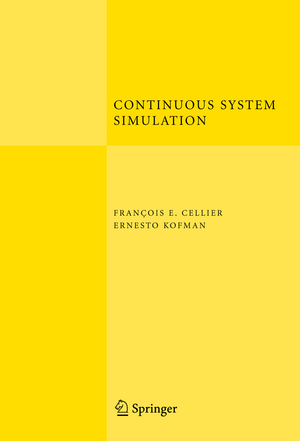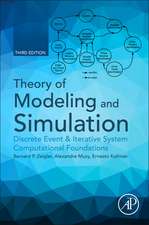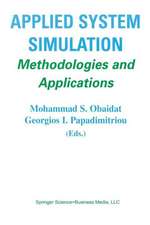Continuous System Simulation
Autor François E. Cellier, Ernesto Kofmanen Limba Engleză Hardback – 15 mar 2006
Modern modeling and simulation environments relieve the occasional user from having to understand how simulation really works. Once a mathematical model of a process has been formulated, the modeling and simulation environment compiles and simulates the model, and curves of result trajectories appear magically on the user’s screen. Yet, magic has a tendency to fail, and it is then that the user must understand what went wrong, and why the model could not be simulated as expected.
Continuous System Simulation is written by engineers for engineers, introducing the partly symbolical and partly numerical algorithms that drive the process of simulation in terms that are familiar to simulation practitioners with an engineering background, and yet, the text is rigorous in its approach and comprehensive in its coverage, providing the reader with a thorough and detailed understanding of the mechanisms that govern the simulation of dynamical systems.
Continuous System Simulation is a highly software-oriented text, based on MATLAB. Homework problems, suggestions for term project, and open research questions conclude every chapter to deepen the understanding of the student and increase his or her motivation.
Continuous System Simulation is the first text of its kind that has been written for an engineering audience primarily. Yet due to the depth and breadth of its coverage, the book will also be highly useful for readers with a mathematics background. The book has been designed to accompany senior and graduate students enrolled in a simulation class, but it may also serve as a reference and self-study guide for modeling andsimulation practitioners.
| Toate formatele și edițiile | Preț | Express |
|---|---|---|
| Paperback (1) | 550.08 lei 6-8 săpt. | |
| Springer Us – 29 oct 2010 | 550.08 lei 6-8 săpt. | |
| Hardback (1) | 668.73 lei 6-8 săpt. | |
| Springer Us – 15 mar 2006 | 668.73 lei 6-8 săpt. |
Preț: 668.73 lei
Preț vechi: 835.92 lei
-20% Nou
Puncte Express: 1003
Preț estimativ în valută:
127.96€ • 133.60$ • 105.90£
127.96€ • 133.60$ • 105.90£
Carte tipărită la comandă
Livrare economică 05-19 aprilie
Preluare comenzi: 021 569.72.76
Specificații
ISBN-13: 9780387261027
ISBN-10: 0387261028
Pagini: 643
Ilustrații: XXII, 644 p. 284 illus.
Dimensiuni: 155 x 235 x 37 mm
Greutate: 1.06 kg
Ediția:2006
Editura: Springer Us
Colecția Springer
Locul publicării:New York, NY, United States
ISBN-10: 0387261028
Pagini: 643
Ilustrații: XXII, 644 p. 284 illus.
Dimensiuni: 155 x 235 x 37 mm
Greutate: 1.06 kg
Ediția:2006
Editura: Springer Us
Colecția Springer
Locul publicării:New York, NY, United States
Public țintă
GraduateCuprins
Introduction, Scope, Definitions.- Modeling and Simulation: A Circuit Example.- Modeling vs. Simulation.- Time and Again.- Simulation as a Problem Solving Tool.- Simulation Software: Today and Tomorrow.- Basic Principles of Numerical Integration.- Introduction.- The Approximation Accuracy.- Euler Integration.- The Domain of Numerical Stability.- The Newton Iteration.- Semi–analytic Algorithms.- Spectral Algorithms.- Single–step Integration Methods.- Introduction.- Runge–Kutta Algorithms.- Stability Domains of RK Algorithms.- Stiff Systems.- Extrapolation Techniques.- Marginally Stable Systems.- Backinterpolation Methods.- Accuracy Considerations.- Step–size and Order Control.- Multi–step Integration Methods.- Introduction.- Newton–Gregory Polynomials.- Numerical Integration Through Polynomial Extrapolation.- Explicit Adams–Bashforth Formulae.- Implicit Adams–Moulton Formulae.- Adams–Bashforth–Moulton Predictor–Corrector Formulae.- Backward Difference Formulae.- Nyström and Milne Algorithms.- In Search for Stiffly–stable Methods.- High–order Backward Difference Formulae.- Newton Iteration.- Step–size and Order Control.- The Startup Problem.- The Readout Problem.- Second Derivative Systems.- Introduction.- Conversion of Second–derivative Models to State–space Form.- Velocity–free Models.- Linear Velocity Models.- Nonlinear Velocity Models.- Stability and Damping of Godunov Scheme.- Explicit and Implicit Godunov Algorithms of Different Orders.- The Newmark Algorithm.- Partial Differential Equations.- Introduction.- The Method of Lines.- Parabolic PDEs.- Hyperbolic PDEs.- Shock Waves.- Upwind Discretization.- Grid–width Control.- PDEs in Multiple Space Dimensions.- Elliptic PDEs and Invariant Embedding.- Finite Element Approximations.-Differential AlgebraicEquations.- Introduction.- Causalization of Equations.- Algebraic Loops.- The Tearing Algorithm.- The Relaxation Algorithm.- Structural Singularities.- Structural Singularity Elimination.- The Solvability Issue.- Differential Algebraic Equation Solvers.- Introduction.- Multi-step Formulae.- Single–step Formulae.- DASSL.- Inline Integration.- Inlining Implicit Runge–Kutta Algorithms.- Stiffly Stable Step–size Control of Radau IIA.- Stiffly Stable Step–size Control of Lobatto IIIC.- Inlining Partial Differential Equations.- Overdetermined DAEs.- Electronic Circuit Simulators.- Multibody System Dynamics Simulators.- Chemical Process Dynamics Simulators.- Simulation of Discontinuous Systems.- Introduction.- Basic Difficulties.- Time Events.- Simulation of Sampled–data Systems.- State Events (1. Multiple Zero Crossings, 2. Single Zero Crossings, Single–step Algorithms, 3. Single Zero Crossings, Multi-step Algorithms, 4. Non–essential State Events).- Consistent Initial Conditions.- Object–oriented Descriptions of Discontinuities ( 1. The Computational Causality of if–Statements, 2. Multi–valued Functions).- The Switch Equation.- Ideal Diodes and Parameterized Curve Descriptions.- Variable Structure Models.- Mixed–mode Integration.- State Transition Diagrams.- Petri Nets.- Real–time Simulation.- Introduction.- The Race Against Time.- Suitable Numerical Integration Methods.- Linearly Implicit Methods.- Multi–rate Integration.- Inline Integration.- Mixed–mode Integration.- Discontinuous Systems.- Simulation Architecture.- Overruns.- Discrete Event Simulation.- Introduction.- Space Discretization: A Simple Example.- Discrete Event Systems and DEVS.- Coupled DEVS Models.- Simulation of DEVS Models.- DEVS and Continuous SystemsSimulation.- Quantized State Systems.- Quantization-based Integration.- Introduction.-
Recenzii
From the reviews:
"This is a graduate-level textbook, a sequel to continuous system modeling … . The text provides a plentiful number of exercises and projects at various levels of difficulty. Each chapter has a carefully selected list of references." (William J. Satzer jun, Zentralblatt MATH, Vol. 1112 (8), 2007)
"This is a graduate-level textbook, a sequel to continuous system modeling … . The text provides a plentiful number of exercises and projects at various levels of difficulty. Each chapter has a carefully selected list of references." (William J. Satzer jun, Zentralblatt MATH, Vol. 1112 (8), 2007)
Textul de pe ultima copertă
Continuous System Simulation describes systematically and methodically how mathematical models of dynamic systems, usually described by sets of either ordinary or partial differential equations possibly coupled with algebraic equations, can be simulated on a digital computer.
Modern modeling and simulation environments relieve the occasional user from having to understand how simulation really works. Once a mathematical model of a process has been formulated, the modeling and simulation environment compiles and simulates the model, and curves of result trajectories appear magically on the user’s screen. Yet, magic has a tendency to fail, and it is then that the user must understand what went wrong, and why the model could not be simulated as expected.
Continuous System Simulation is written by engineers for engineers, introducing the partly symbolical and partly numerical algorithms that drive the process of simulation in terms that are familiar to simulation practitioners with an engineering background, and yet, the text is rigorous in its approach and comprehensive in its coverage, providing the reader with a thorough and detailed understanding of the mechanisms that govern the simulation of dynamical systems.
Continuous System Simulation is a highly software-oriented text, based on MATLAB. Homework problems, suggestions for term project, and open research questions conclude every chapter to deepen the understanding of the student and increase his or her motivation.
Continuous System Simulation is the first text of its kind that has been written for an engineering audience primarily. Yet due to the depth and breadth of its coverage, the book will also be highly useful for readers with a mathematics background. The book has been designed to accompany senior and graduate students enrolled in a simulation class, but it may also serve as a reference and self-study guide for modeling andsimulation practitioners.
Modern modeling and simulation environments relieve the occasional user from having to understand how simulation really works. Once a mathematical model of a process has been formulated, the modeling and simulation environment compiles and simulates the model, and curves of result trajectories appear magically on the user’s screen. Yet, magic has a tendency to fail, and it is then that the user must understand what went wrong, and why the model could not be simulated as expected.
Continuous System Simulation is written by engineers for engineers, introducing the partly symbolical and partly numerical algorithms that drive the process of simulation in terms that are familiar to simulation practitioners with an engineering background, and yet, the text is rigorous in its approach and comprehensive in its coverage, providing the reader with a thorough and detailed understanding of the mechanisms that govern the simulation of dynamical systems.
Continuous System Simulation is a highly software-oriented text, based on MATLAB. Homework problems, suggestions for term project, and open research questions conclude every chapter to deepen the understanding of the student and increase his or her motivation.
Continuous System Simulation is the first text of its kind that has been written for an engineering audience primarily. Yet due to the depth and breadth of its coverage, the book will also be highly useful for readers with a mathematics background. The book has been designed to accompany senior and graduate students enrolled in a simulation class, but it may also serve as a reference and self-study guide for modeling andsimulation practitioners.
Caracteristici
Includes homework problems, suggestions for research projects, and open-ended questions at the end of each chapter Includes supplementary material: sn.pub/extras












